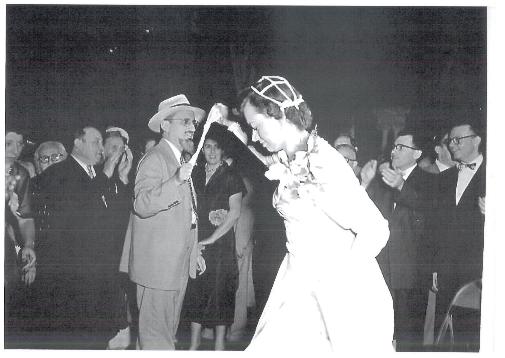Marc B. Shapiro published this photo:

S. comments: "That picture of R. Soloveitchik doing the mitzvah tantz is hilarious. Is it only me, or does the frozen half smile on his face look like internally he is feeling a cross between mortified and nauseous?"
The Memoirs of Nahum N. Glatzer (New York, 1997), pp. 126-128. Although Glatzer left Orthodoxy, in his younger years he studied in R. Salomon Breuer’s yeshiva in Frankfurt, and also with R. Nehemiah Nobel. As such, he understood Orthodoxy very well. Glatzer, who died in 1990, was retired when I came to Brandeis in 1985. To my great regret, I never took the trouble to interview him as I did with Prof. Alexander Altmann, who retired from Brandeis in 1976. On pp. 129-130 of Glatzer’s memoir we find the following, which I am sure will interest many readers of the Seforim blog.
In 1944 Rabbi Joseph Soloveitchik (called “the Rov” by his followers and admirers) published in Talpiot a major article, “Ish ha-Halakhah” (the Halakhic Personality). The essay, written in a most beautiful Hebrew style, not only claimed for the observance of Jewish law the central place in Jewish life, but denied the—however circumscribed—validity of any other approach. The Halakhah demands a complete control of the Jew, to the exclusion of an emotional state of mind to accompany the halakhc function. There is no rightful place for, or justification of, a state of excitement or religious agitation, say, in the ceremony of blowing the shofar on New Year’s Day; what matters, and matters exclusively, is the proper execution of the ritual.
This exclusion of the emotional side of religion bothered me when I read the essay. I planned a polemic reply but was dissuaded by my colleagues. I happened to visit New York and voiced my feelings to Professor Louis Ginzberg, the great Talmudist. I expected him to agree with me and object to the rigid stand of the Rov. The cautious Ginzberg did not wish to commit himself, or to say something that could be quoted as a criticism of his Talmudic colleague. He, therefore, did not go beyond saying: “I like my whiskey straight,” which was a mild complaint against the Rov’s combination of Halakhah and philosophy. The only reference that could be interepreted as an admission of esthetics into the realm of religion was Ginzberg’s telling of the Gaon of Vilna (brother of Rabbi Abraham, Ginzberg’s forebear in the seventh generation), who near death admired the beauty of the etrog that was brought to him, since the day was one of the Sukkot festival days.
(The Rov, apparently, would have felt: Never mind the etrog’s beauty. What matters is that the citron is without blemish and the benediction is properly pronounced.).
I was disappointed that Ginzberg did not wish to take seriously the younger man’s question. In the meantime, the Rov changed his position and realized the wider dimension of faith. If you wait long enough . . . [ellipsis in original]. Yet, even with the changed position on the part of the Rov, Ginzberg, were he alive, would insist on having his whiskey straight.
